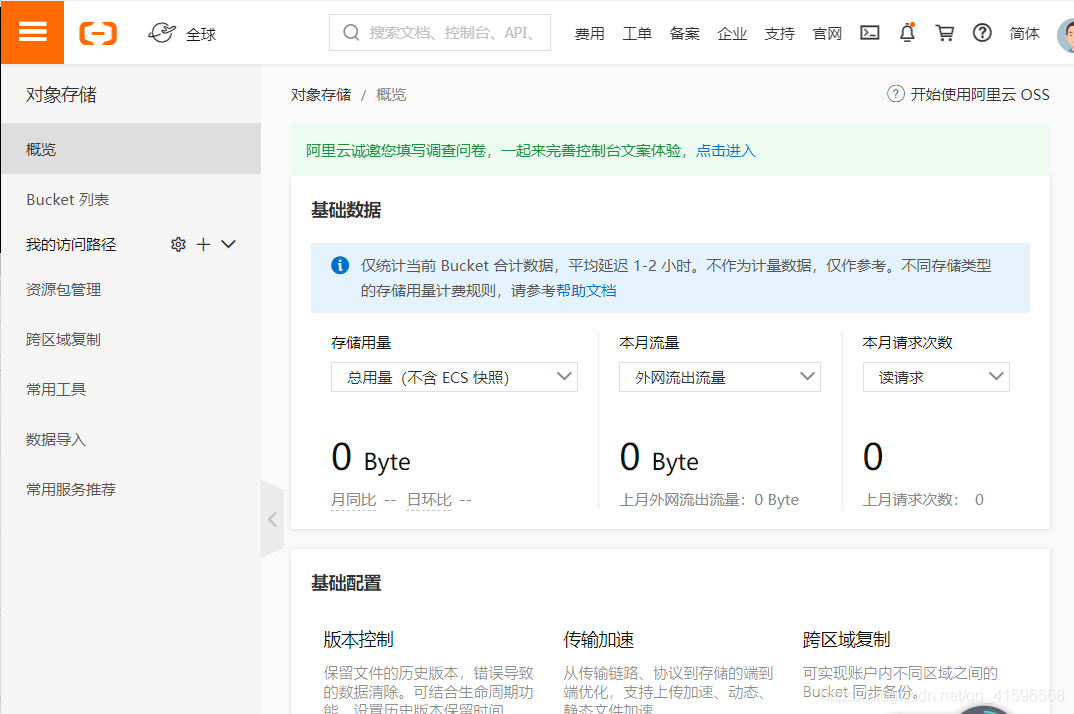文章目录
【笔记于学习尚硅谷课程所作】
2.1文件云存储

云存储上传示意图:服务端签名后直传

(1)配置阿里云
本项目采用阿里云云存储,首先注册
1.登陆阿里云
2.找到对象存储OSS,开通服务,进入控制台

3.创建Bucket

4.开通AccessKey–>选择开通子用户的

5.添加读写权限

6.在基础设置里设置跨域访问

(2)建立第三方服务项目
0.对项目进行基本配置
1.引入依赖(common也要引入)
<!--对象云存储的jar-->
<dependency>
<groupId>com.alibaba.cloud</groupId>
<artifactId>spring-cloud-starter-alicloud-oss</artifactId>
<version>2.1.1.RELEASE</version>
</dependency>
2.配置项目yml
alicloud:
access-key: LTAI4G93uUebfuH6ccWcwY3H
secret-key: KvlZ7v6J68Txex04kTdGF2SS2WGvtJ
oss:
endpoint: oss-cn-chengdu-internal.aliyuncs.com
bucket: gulimall-hanhan
3.配置Controller(实现服务端签名后直传)
@RestController
public class OssController {
@Autowired
OSS ossClient;
@Value("${spring.cloud.alicloud.oss.endpoint}")
private String endpoint;
@Value("${spring.cloud.alicloud.oss.bucket}")
private String bucket;
@Value("${spring.cloud.alicloud.access-key}")
private String accessId;
@RequestMapping("/oss/policy")
public R policy() {
// host的格式为 bucketname.endpoint
String host = "https://" + bucket + "." + endpoint;
// callbackUrl为 上传回调服务器的URL,请将下面的IP和Port配置为您自己的真实信息。
String format = new SimpleDateFormat("yyyy-MM-dd").format(new Date());
String dir = format + "/"; // 用户上传文件时指定的前缀。
Map<String, String> respMap = null;
try {
long expireTime = 30;
long expireEndTime = System.currentTimeMillis() + expireTime * 1000;
Date expiration = new Date(expireEndTime);
PolicyConditions policyConds = new PolicyConditions();
policyConds.addConditionItem(PolicyConditions.COND_CONTENT_LENGTH_RANGE, 0, 1048576000);
policyConds.addConditionItem(MatchMode.StartWith, PolicyConditions.COND_KEY, dir);
String postPolicy = ossClient.generatePostPolicy(expiration, policyConds);
byte[] binaryData = postPolicy.getBytes("utf-8");
String encodedPolicy = BinaryUtil.toBase64String(binaryData);
String postSignature = ossClient.calculatePostSignature(postPolicy);
respMap = new LinkedHashMap<String, String>();
respMap.put("accessid", accessId);
respMap.put("policy", encodedPolicy);
respMap.put("signature", postSignature);
respMap.put("dir", dir);
respMap.put("host", host);
respMap.put("expire", String.valueOf(expireEndTime / 1000));
} catch (Exception e) {
System.out.println(e.getMessage());
}
return R.ok().put("data", respMap);
}
}
4.设置网关(网关的配置的参考)